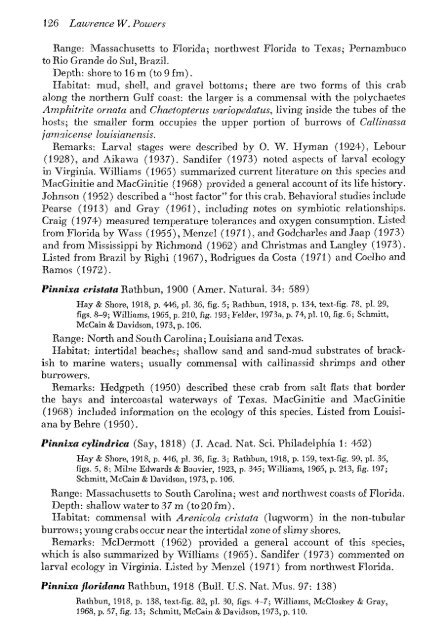You also want an ePaper? Increase the reach of your titles
YUMPU automatically turns print PDFs into web optimized ePapers that Google loves.
126 Lawrence W. Powers<br />
Range: Massachusetts to Florida; northwest Florida to Texas; Pernambuco<br />
to Rio Grande do Sul, Brazil.<br />
Depth: shore to 16 m (to 9 fm).<br />
Habitat: mud, shell, and gravel bottoms; there are two forms of this crab<br />
along the northern Gulf coast: the larger is a commensal with the polychaetes<br />
Amphitrite ornata and Chaetopterus variopedatus, living inside the tubes of the<br />
hosts; the smaller form occupies the upper portion of burrows of Callinassa<br />
jamaicense louisianensis.<br />
Remarks: Larval stages were described by 0. W. Hyman (1924), Lebour<br />
(1928), and Aikawa (1937). Sandifer (1973) noted aspects of larval ecology<br />
in Virginia. Williams (1965) summarized current literature on this species and<br />
MacGinitie and MacGinitie (1968) provided a general account of its life history.<br />
Johnson (1952) described a "host factor" for this crab. Behavioral studies include<br />
Pearse (1913) and Gra}^ (1961), including notes on symbiotic relationships.<br />
Craig (1974) measured temperature tolerances and oxygen consumption. Listed<br />
from Florida by Wass (1955), Menzel (1971), and Godcharles and Jaap (1973)<br />
and from Mississippi by Richmond (1962) and Christmas and Langley (1973).<br />
Listed from Brazil by Righi (1967), Rodrigues da Costa (1971) and Coelho and<br />
Ramos (1972).<br />
Pinnixa cristata V^aXhhun, 1900 (Amer. Natural. 34: 589)<br />
Hay & Shore, 1918, p. 446, pi. 36, fig. 5; Rathbun, 1918, p. 134, text-fig, 78, pi. 29,<br />
figs. 8-9; Williams, 1965, p. 210, fig. 193; Felder, 1973a, p. 74, pi. 10, fig. 6; Schmitt,<br />
McCain & Davidson, 1973, p. 106.<br />
Range: North and South Carolina; Louisiana and Texas.<br />
Habitat: intertidal beaches; shallow sand and sand-mud substrates of brackish<br />
to marine waters; usually commensal with callinassid shrimps and other<br />
burrowers.<br />
Remarks: Hedgpeth (1950) described these crab from salt flats that border<br />
the bays and intercoastal waterways of Texas. MacGinitie and MacGinitie<br />
(1968) included information on the ecology of this species. Listed from Louisiana<br />
by Behre (1950).<br />
Pinnixa cylindrica (Say, 1818) (J. Acad. Nat. Sci. Philadelphia 1: 452)<br />
Hay & Shore, 1918, p. 446, pi. 36, fig. 3; Rathbun, 1918, p. 159, text-fig. 99, pi. 35,<br />
figs. 5, 8; Milne Edwards & Bouvier, 1923, p. 343; Williams, 1965, p. 213, fig. 197;<br />
Schmitt, McCain & Davidson, 1973, p. 106.<br />
Range: Massachusetts to South Carolina; west and northwest coasts of Florida.<br />
Depth: shallow water to 37 m (to20fm).<br />
Habitat: commensal with Arenicola cristata (lugworm) in the non-tubular<br />
burrows; young crabs occur near the intertidal zone of slimy shores.<br />
Remarks: McDermott (1962) provided a general account of this species,<br />
which is also summarized by Williams (1965). Sandifer (1973) commented on<br />
larval ecology in Virginia. Listed by Menzel (1971) from northwest Florida.<br />
Pinnixa floridana Rathbun, 1918 (Bull, U.S. Nat. Mus. 97: 138)<br />
Rathbun, 1918, p. 138, te.\t-fig. 82, pi. 30, figs. 4-7; Williams, McCloskey & Gray,<br />
1968, p. 57, fig. 13; Schmitt, McCain & Davidson, 1973, p. 110.

















